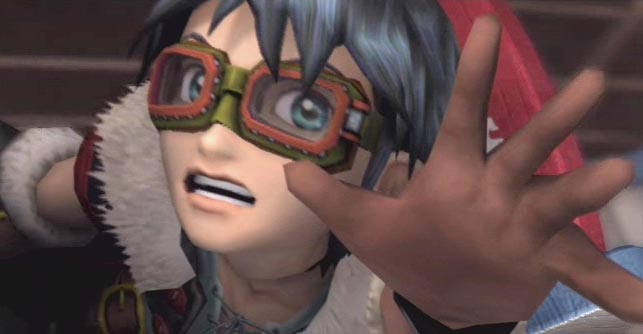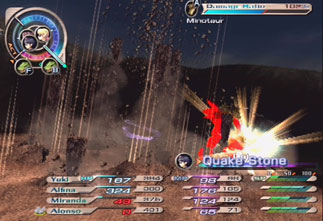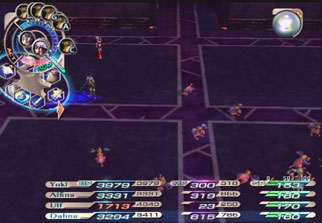A review of Grandia 3
While it is slightly less well known in English speaking lands, the Grandia series is very popular in Japan. Popular enough to warrant two sequels and a spin-off dungeon RPG.
The keys to the games success are its strong plot, the attention to detail and design put into its worlds, and most importantly, its battle system, which is particularly good.

The battle system is a strange mix of turn-based and real time. Characters wait until their turn comes, like any other RPG. However, events happen in real time as they wait. When their turn does come, the action pauses while the player choses which action they would like them to take, then they act in real time.
An example: want to hit a monster? One of your characters will have to run over there and attack it. In the meantime, everyone else on the battlefield will be carrying out their moves as well...
One of the consequences of this is that from time to time a character or a monster may be struck while they themselves are in the middle of acting. In most other RPGs, so long as they stayed above 0HP this would have no consequences; however in Grandia, being hit while acting slows down your character's (or your enemy's) own action - and may even cancel it completely, robbing you of your turn (or them of their turn).

Poke!
Even if a character is not currently acting, taking damage will delay when their next turn happens, so damage has two roles in Grandia games - killing enemies, and managing the battlefield.
Many saw the original Grandia as revolutionary - it had this great battle system, 2D animated characters but a 3D polygonated world, plus it ditched random encounters - letting you see and avoid enemies in the field. If you managed to get behind an enemy and walk into it, the game gave you an initiative in the upcoming fight - and vice versa.

In Grandia 3, some spells send enemies flying into the air. Hitting an enemy with a critical attack when it is off balance does will send it flying too. Attack an enemy that is in the air, and you are rewarded with an aerial move. A nice twist to the fights, but they've taken away the combo attacks from the last game... =(
The game wasn't without its flaws though. Towards the second half, the developers loved creating narrow paths full of enemies for you to fight; then forcing you to go up and down them several times. And then forcing you to do it all again, because you needed to do a lot of level grinding for the last boss. This bad balancing extended the time it took to clear the game by about 10 or 20 hours, at a cost of causing utter frustration to anyone trying to finish it.
And it was a bit silly that you had to repeatedly run into a spike-traps and then heal for a few hours, in order to level up your healing spells.
The game was released on the Saturn in Japan, but never saw an English release. It did eventually make it as a playstation 1 port a little later, but everyone was wooing over Final Fantasy 7, which was a little less advanced technically, but had its gameplay and balancing down to a tee.

Grandia 3 isn't afraid to bring out the fmv where needed - usually. There are a couple of scenes that are cheaply done, but arguably you only need to see so many FMVs of airplanes crashing before you get the idea.
Airplane crashes in Grandia usually total the plane, but miraculously everyone on board always seems to get out pretty much unscaved.
It wasn't until the start of the next generation and the Dreamcast until we saw Grandia 2. This time, the game was in full 3D, the plot was as strong as ever, and the battle system had been smoothed to perfection. Grandia 2 is probably the best in the series, and you should play it in preference to the other three.
The only real flaw of the game was that it was slightly too easy - GameArts never could seem to get the balancing right. But at least that made it more accessible than the previous game.

Er, I can't think of a witty caption for this. Suffice to say, it's a big explosion. There are a lot of pyrotechnics involved when casting spells.
Rather than jump to number 3, the next entry in the series was a dungeon RPG on the Playstation 2 with the silly name of "Xtreme".
The team had obviously had a world planned out, however they cut it down to a mere two towns, with any characters turning up by invitation when needed, and any traveling to dungeons done by selecting locations from a map. The lack of locations also meant that pretty much all of the plot consisted of the main character arguing with the villain, then when he is wheeled out of the way, another villain.
These omissions had some Grandia fans reaching, but others (me included) found merit in the replayability offered by the game, which went on for a long time after it was supposedly "finished", as did all of the sub-plots, which was a very nice touch.
The battle system was the tightest it has ever been as well, with a lot of room for character customization.

No Dear, he's got a really huge sword. I rather think that we should run...
And so, after a long gap, we finally have Grandia 3.
So what's new?
The game engine has been given a slight graphical boost since Xtreme, however the most noticeable improvement is that the cutscenes are now done with different character models with a higher polygon count, and are properly motion captured as well.
As a result, the game looks amazing. There are a lot of FMVs as well, however the game manages a heck of a lot in the game engine, only bailing out to FMV when it really needs to.
Grandia games have always had a very strong soundtrack. I think most people would agree with me that the score for Grandia 3 is not quite up there with them, however it is still pretty good.
The battle system is as strong as ever. There haven't been many improvements this time; just a couple of gimmicks thrown in, such as aerial combos.

Lucky Minx are a good way to level up quickly. You start finding them in abundance before the last boss, making leveling up to beat it less of a chore. Problem is, you don't start finding them until slightly after the totally unbalanced fight that you need to spend hours leveling up for...
But unfortunately, in the end playing Grandia 3 reminds me of the first game; after a certain point the complete lack of balance makes the game turn into torture, despite how good the rest of the game is.
I literally had to spend a couple of days one weekend leveling up before I could do one of the bosses.
The fight was so difficult because it has three parts, each of which moved through the IP gage extremely quickly, and each of which spent their time utterly nuking the party with magic.
There's a limit-break like move which keeps repeatedly healing your party, and the key to winning is using that move at the start of the game, then taking at least one of the parts out before it wears off, and you are toast.
The problem being, they have several thousand HP. I have spent the best part of this weekend just leveling up, trying to get to the point where I could easily take this thing on.
And that's not the only time this has happened. The last boss is also very tough - and by tough, read cheap. It's possible that you might have to go leveling, again, in order to beat it.
Anyway, unless you stop halfway through, you are going to walk into this as well.
The start of the game was great, but I honestly can't recommend the game as a whole, knowing that the balance is so screwed up.

Of course, the catch is that Lucky Minx are hard to kill. Nevertheless, I am trying my hardest.
At the end of the day, if you don't mind level grinding, you'll beat the game eventually either way.
Unfortunately, nothing can stop the fact that the plot in the game is pretty poor in places.
Grandia is a really odd game in this respect. The plot seems as if two different people have written it.
For most of the first disk, the plot is pretty strong, and revolves around the main character - Yuki - wanting to get his hands on an airplane and become a pilot, and around his relationship with his mother.
But about a third of the way through, he gets his plane, leaves his mother, gets a couple of very stereotypical party members in replacement, and the rest of the game turns into a "hunt the orbs and prevent the world from being destroyed" affair.
If you want a number by this game, then I'd say it should score 7.5 out of 10. Is it worth getting? If you are a big fan of the Grandia series, then yes.
If you are not, then try getting Grandia 2 on the Dreamcast (supposedly the ps2 port is lousy) and playing that first - it's the better game of the two.